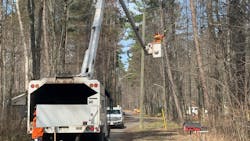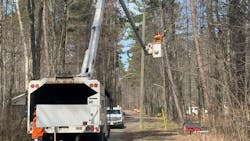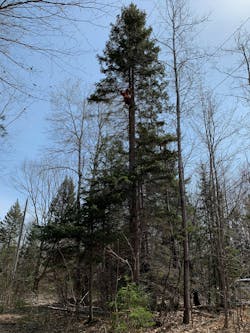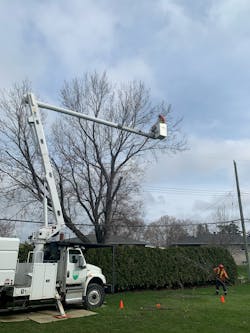North of Michigan, straddling Lakes Superior and Huron, are the Algoma, Sudbury and Nipissing Districts of Northeastern Ontario, Canada. Spanning close to 41,000 square miles, this area is home to about 220,000 residents and served by three municipal utilities: The Public Utilities Commission of the City of Sault Ste. Marie (PUC), North Bay Hydro and Greater Sudbury Hydro.
With an increasingly older population and a declining birth rate, the province of Ontario, including its many rural communities, has been facing a significant labor shortage. For the local utilities, an insufficient number of apprentices graduating from the skilled trades was negatively impacting their vegetation management operations—a high risk activity requiring quality contractors.
Following an encounter at an industry trade event, 2019 became a turning point. What initially began as a conversation among the three utilities about the challenges of not only locating high quality contractors but also mitigating the risk of new contractors entering their properties and performing hazardous activities, turned into a groundbreaking idea when the concept of a shared workforce was born.
As the conversation gained momentum over the subsequent weeks, a detailed partnership model emerged in which the three utilities would no longer have to fight over limited resources. By joining forces, the utilities could offer full-time, year-round, consistent employment with competitive pay and good benefits. This valuable employee benefit was not feasible when operating independently and would allow the utilities to maintain continuity of staff and lower turnover.
Forming 17 Trees
In June 2019, PUC, North Bay Hydro and Greater Sudbury Hydro jointly established an independent vegetation management contractor, 17 Trees, named after Highway 17, the primary route of the Trans-Canada Highway connecting the three districts. Immediately, 17 Trees became a destination employer for well-trained, quality employees.
As the former founder and president of a local utility line clearance company, finding the right leadership to run this jointly owned company was not difficult. The utilities were fortunate to hire talent with 20 to 25 years of experience in this line of business. Instead, the greatest concern at the time was technology. How would a system be designed to enable collaboration among multiple utilities?
During the discovery phase, a few common requirements emerged. The system needed to be field-friendly to foster adoption readily. Additionally, given the need to share work groups among independent utilities, the companies could not rely upon any paper-based processes. The utilities needed a fully integrated technology solution that was compatible with their respective ArcGIS systems to interact with their existing data. Moreover, as customer-centric, community utilities, they needed the flexibility to accommodate customer issues on any of their properties as they arise. As such, the solution needed to provide full visibility to all vegetation management work for a holistic view of 17 Trees.
The timing was right. PUC was in the process of rolling out a Clearion solution for maintenance program planning and asset inspections. Strategically, this was a key component of its “office in a truck” initiative. While the Board of Directors for 17 Trees evaluated a number of potential vegetation management software providers for this joint endeavor, PUC ultimately selected Clearion as a natural extension of these capabilities.
System Development
Typically, the traditional work management system is designed for one utility to manage multiple contractors. In their business model, the companies needed to flip that model to accommodate three utilities with a shared contractor. They quickly learned there’s no functional difference. The greater challenges they faced were in how each utility a) manages their vegetation management operations and b) houses their data.
To gain a better understanding of how to develop a robust solution, they began by outlining their individual approaches to line clearance. Each of their utilities was on a different maintenance cycle and used dissimilar work planning methods. One utility had a greater amount of reactive work and managed a high number of customer tickets. Rather than force themselves to adopt similar practices, which may not have been optimal for their utilities and their customers, Clearion designed the shared platform to accommodate their differences.
Furthermore, to ensure a seamless deployment, the development team began mapping each utility’s background data into one schema to avoid having to adjust settings for each. A single configuration was designed that connected three separate databases using common settings to point to specific field names.
Today, each utility has a view of its own system and can feed reactive and maintenance work into the queue. Work planners can switch between the three utilities to manage the shared work groups. The process is both easy and seamless and enables all stakeholders to monitor and track crew productivity. In short, developing shared technology to serve three utilities was made simple.
Positive Outcomes
Last Christmas, Northeastern Ontario experienced a major ice storm. Collectively, the utilities responded almost immediately.
Vegetation management crews were deployed to help restore power within hours. Without 17 Trees and their newly integrated work management system, they could not have provided such a high degree of service to their customers.
Not only have our service levels increased, but this investment has also provided the utilities with predictability of cost. Each utility can plan the number of hours required at beginning of the year and operate within reasonable assumptions. With real-time visibility to output and budget-based reporting, the utilities can ensure they’re receiving the right level of value for their respective investments.
Most importantly, they have established extremely low incident rates for the industry with no significant events in two years of operation. With their own workforce, the utilities have gained greater control over safety, quality, training and customer service—effectively becoming a premium contractor—all while maintaining low, competitive rates for their customers.
Without a moment of serendipity at an industry event, independently the utilities might still be struggling to meet their labor demands. Today, the utilities have a strategy in place to meet their long-term customer needs—from a service and rate-payer perspective—and be an employer of choice.
Rob Brewer ([email protected]) is the president and CEO of PUC Inc.
About the Author
Rob Brewer
Rob Brewer ([email protected]) is the president and CEO of PUC Inc.





